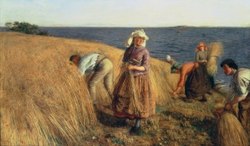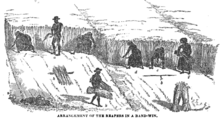
A threshing machine or a thresher is a piece of farm equipment that threshes grain, that is, it removes the seeds from the stalks and husks. It does so by beating the plant to make the seeds fall out.

Cyrus Hall McCormick was an American inventor and businessman who founded the McCormick Harvesting Machine Company, which later became part of the International Harvester Company in 1902. Originally from the Blue Ridge Mountains of Virginia, he and many members of the McCormick family became prominent residents of Chicago. McCormick has been simplistically credited as the single inventor of the mechanical reaper. He was, however, one of several designing engineers who produced successful models in the 1830s. His efforts built on more than two decades of work by his father Robert McCormick Jr., with the aid of Jo Anderson, who was enslaved by the family. He also successfully developed a modern company, with manufacturing, marketing, and a sales force to market his products.

The Corn Laws were tariffs and other trade restrictions on imported food and corn enforced in the United Kingdom between 1815 and 1846. The word corn in British English denotes all cereal grains, including wheat, oats and barley. They were designed to keep corn prices high to favour domestic producers, and represented British mercantilism. The Corn Laws blocked the import of cheap corn, initially by simply forbidding importation below a set price, and later by imposing steep import duties, making it too expensive to import it from abroad, even when food supplies were short. The House of Commons passed the corn law bill on 10 March 1815, the House of Lords on 20 March and the bill received royal assent on 23 March 1815.

A scythe is an agricultural hand tool for mowing grass or harvesting crops. It is historically used to cut down or reap edible grains, before the process of threshing. The scythe has been largely replaced by horse-drawn and then tractor machinery, but is still used in some areas of Europe and Asia. Reapers are bladed machines that automate the cutting of the scythe, and sometimes subsequent steps in preparing the grain or the straw or hay.
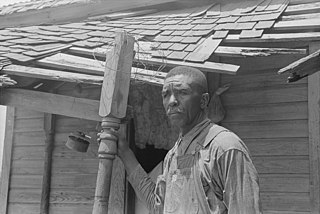
A tenant farmer is a person who resides on land owned by a landlord. Tenant farming is an agricultural production system in which landowners contribute their land and often a measure of operating capital and management, while tenant farmers contribute their labor along with at times varying amounts of capital and management. Depending on the contract, tenants can make payments to the owner either of a fixed portion of the product, in cash or in a combination. The rights the tenant has over the land, the form, and measures of payment vary across systems. In some systems, the tenant could be evicted at whim ; in others, the landowner and tenant sign a contract for a fixed number of years. In most developed countries today, at least some restrictions are placed on the rights of landlords to evict tenants under normal circumstances.

Calan Gaeaf is the name of the first day of winter in Wales, observed on 1 November. The night before is Nos Galan Gaeaf or Noson Galan Gaeaf, an Ysbrydnos when spirits are abroad. Traditionally, people avoid churchyards, stiles, and crossroads, since spirits are thought to gather there. The term is first recorded in literature as 'Kalan Gayaf' in the laws of Hywel Dda.

A reaper is a farm implement or person that reaps crops at harvest when they are ripe. Usually the crop involved is a cereal grass. The first documented reaping machines were Gallic reapers that were used in Roman times in what would become modern-day France. The Gallic reaper involved a comb which collected the heads, with an operator knocking the grain into a box for later threshing.

Threshing, or thrashing, is the process of loosening the edible part of grain from the straw to which it is attached. It is the step in grain preparation after reaping. Threshing does not remove the bran from the grain.
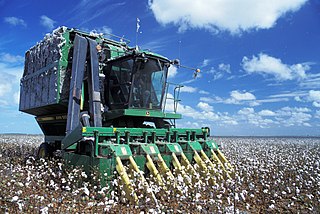
Mechanised agriculture or agricultural mechanization is the use of machinery and equipment, ranging from simple and basic hand tools to more sophisticated, motorized equipment and machinery, to perform agricultural operations. In modern times, powered machinery has replaced many farm task formerly carried out by manual labour or by working animals such as oxen, horses and mules.
Pe'ah is the second tractate of Seder Zeraim of the Mishnah and of the Talmud. This tractate begins the discussion of topics related to agriculture, the main focus of this seder (order) of the Mishnah. The tractate discusses the laws of gifts to the poor when a person harvests their field, vineyards or trees, based on commandments in the Torah. The tractate also deals with the laws of giving charity in general. The tractate is called Pe'ah because the first part of the tractate deals with the laws of Pe'ah, while the remaining part of the tractate deals with a number of other related topics.
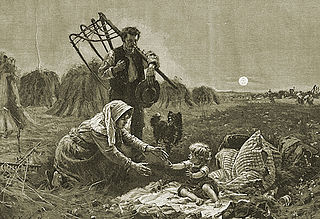
A grain cradle or cradle, is a modification to a standard scythe to keep the cut grain stems aligned. The cradle scythe has an additional arrangement of fingers attached to the snaith to catch the cut grain so that it can be cleanly laid down in a row with the grain heads aligned for collection and efficient threshing.

Captain Frederick William Leopold Thomas, c.1812–1885, RN, FSA (Scot) was a naval officer, photographer, and historian, noted for his surveys of Scotland, and for taking the first photographs of St Kilda.
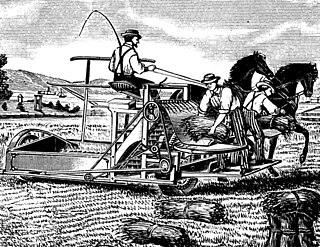
Marsh, Steward & Company began with the invention and patent of a reaper-harvester by brothers Charles Wesley Marsh and W. W. Marsh of De Kalb, Illinois in August 1858. By 1863 the improved machine, known as the Marsh Harvester, was manufactured at Plano, Illinois by C. W. Marsh and George Steward, under the firm name of Steward and Marsh. W.W.Marsh and Lewis Steward joined the company in the 1860s. In October, 1875, the business was sold to Gannon and Deering, of Chicago, Illinois.

Arles: View from the Wheat Fields was painted by Vincent van Gogh in June 1888, among a number of paintings he made of wheat fields that summer. It is currently displayed at the Musee Rodin in Paris, France.

Wheat Fields is a series of dozens of paintings by Dutch Post-Impressionist artist Vincent van Gogh, borne out of his religious studies and sermons, connection to nature, appreciation of manual laborers and desire to provide a means of offering comfort to others. The wheat field works demonstrate his progression as an artist from the drab Wheat Sheaves made in 1885 in the Netherlands to the colorful and dramatic 1888–1890 paintings from Arles, Saint-Rémy and Auvers-sur-Oise in rural France.
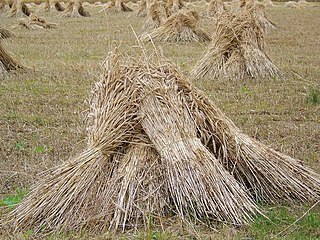
A sheaf (/ʃiːf/) is a bunch of cereal-crop stems bound together after reaping, traditionally by sickle, later by scythe or, after its introduction in 1872, by a mechanical reaper-binder.

The history of agriculture in Scotland includes all forms of farm production in the modern boundaries of Scotland, from the prehistoric era to the present day.
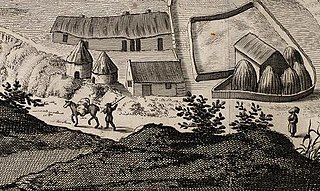
Agriculture in Scotland in the early modern era includes all forms of farm production in the modern boundaries of Scotland, between the establishment of the Renaissance in the early sixteenth century and the beginning of the Industrial Revolution in the mid-eighteenth century. This era saw the impact of the Little Ice Age, which peaked towards the end of the seventeenth century. Almost half the years in the second half of the sixteenth century saw local or national scarcity, necessitating the shipping of large quantities of grain from the Baltic. In the early seventeenth century famine was relatively common, but became rarer as the century progressed. The closing decade of the seventeenth century saw a slump, followed by four years of failed harvests, in what is known as the "seven ill years", but these shortages would be the last of their kind.

The Seven Ill Years, also known as the Seven Lean Years, is the term used for a period of widespread and prolonged famine in Scotland during the 1690s, named after the Biblical famine in Egypt predicted by Joseph in the Book of Genesis. Estimates suggest between 5 to 15% of the total Scottish population died of starvation, while in areas like Aberdeenshire death rates may have reached 25%. One reason the shortages of the 1690s are so well remembered is because they were the last of their kind.

The name horkey was applied to end of harvest customs and celebrations, especially in the Eastern Counties of England, although the word occurred elsewhere in England and also Ireland. Since it is found in dialect, there is no standard spelling and other versions include hawkie and hockey. Mentioned from the 16th century onward, the custom became less common during the course of the 19th century and was more or less extinct in the 20th. It is chiefly remembered now because of the poem dedicated to it by Robert Bloomfield in 1802.
